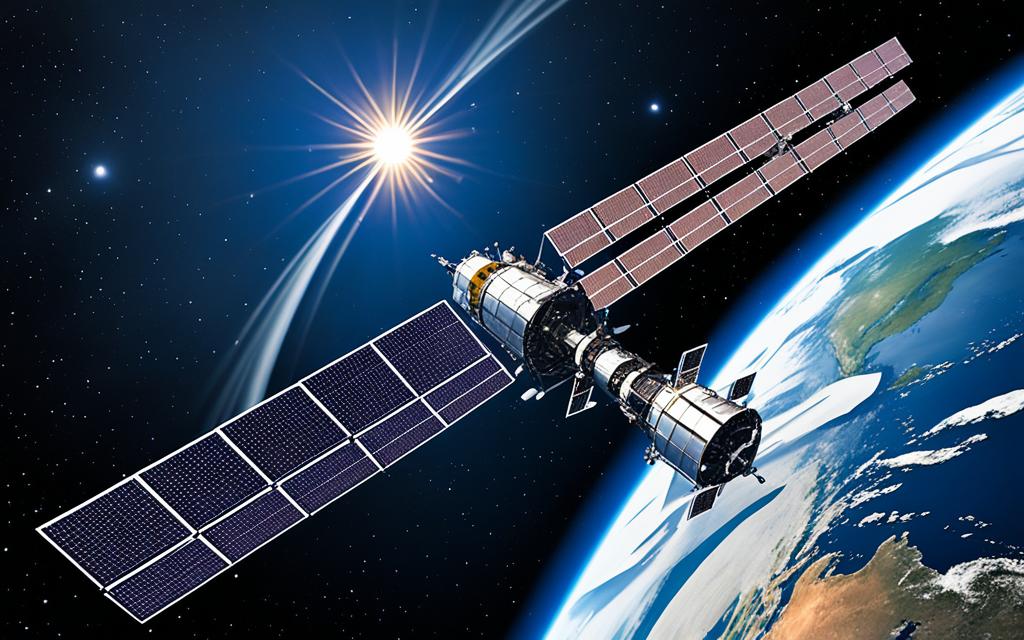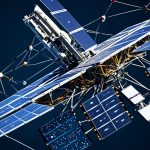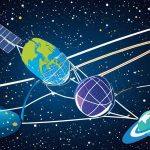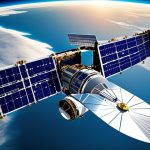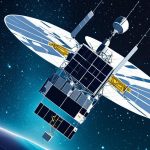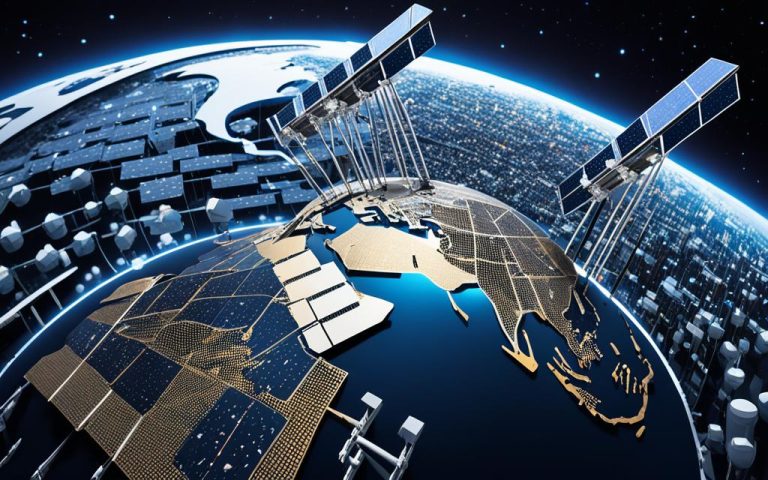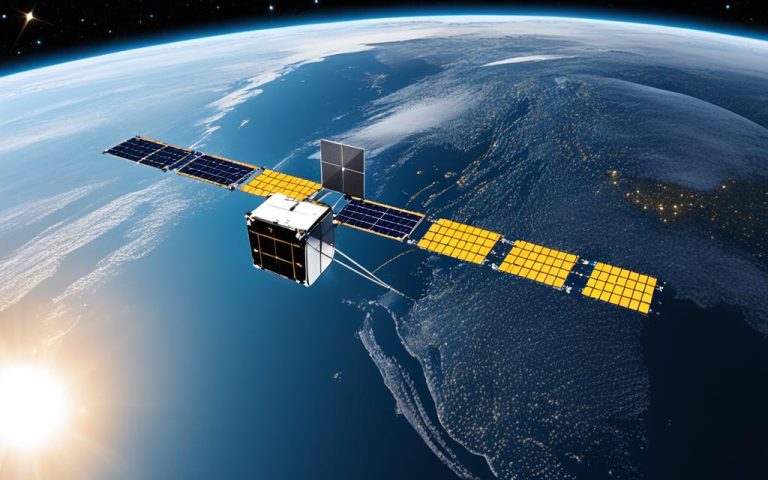Geostationary Satellites are a crucial component of global communication and broadcasting systems.
These satellites, orbiting at the same speed as the Earth’s rotation, remain fixed in a specific position relative to the Earth’s surface, allowing uninterrupted and reliable communication services. Geostationary Satellites play a vital role in providing internet access, television broadcasting, and telephony services.
Companies like Amazon are recognizing the significance of Geostationary Satellites and investing in satellite ventures such as Project Kuiper. These endeavors aim to expand telecommunications capabilities and provide internet access to remote areas.
Discover more about the role of Geostationary Satellites in communication and broadcasting, their challenges, and future prospects.
The Race for Satellite Internet Dominance
In recent years, there has been a surge in the development of satellite constellations for broadband internet services. Companies like Amazon and SpaceX are at the forefront of this race, with their projects Project Kuiper and Starlink, respectively. These ambitious initiatives aim to deploy thousands of satellites in Low Earth Orbit (LEO) to provide high-speed internet access to even the most remote areas of the planet.
The competition between Amazon Project Kuiper and SpaceX Starlink, along with other players in the space, is driving technological advancements and innovations. The deployment of LEO constellations presents numerous benefits in terms of global connectivity and improved internet access. Low Earth Orbit allows for reduced latency and faster data transmission, enabling a seamless browsing experience for users worldwide.
“The future of satellite internet lies in LEO constellations like Amazon’s Project Kuiper and SpaceX’s Starlink. These ambitious projects have the potential to revolutionize internet connectivity and bridge the digital divide.” – Industry Expert
While the race for satellite internet dominance is gaining momentum, it is not without its challenges. Orbital congestion and spectrum allocation are among the key obstacles that need to be addressed. As more constellations are deployed, issues of space traffic management and satellite collision risks become more significant. However, the industry is actively working on solutions to ensure safe and sustainable operations.
Advancements in satellite technology and the increasing competition among players like Amazon and SpaceX are driving the future of broadband connectivity. With the potential to provide high-speed internet access to underserved areas, LEO constellations are poised to transform how we connect and communicate globally.
Benefits of LEO Constellations for Broadband Internet:
- Global coverage, bringing high-speed internet to remote areas
- Reduced latency for faster data transmission
- Potential for increased competition and lower costs for consumers
- Improved reliability and resilience of internet connectivity
Challenges and Opportunities for Geostationary Satellite Operators
Geostationary satellite operators, such as ABS, Spacecom, and OneWeb, are facing significant challenges in the ever-evolving satellite industry. While these operators have established satellite businesses serving the broadcast community, they must adapt to the changing landscape to remain competitive.
ABS, a leading satellite operator, is proactively focusing on filling its existing satellites to capacity before embarking on new projects. By maximizing the efficiency of its current satellite fleet, ABS aims to optimize revenue and position itself for future growth.
Spacecom, another key player in the industry, is carefully evaluating future investments to ensure sustained success. The company is exploring potential partnerships with non-geostationary (GEO) satellite operators, recognizing the need to diversify its portfolio and take advantage of emerging opportunities.
OneWeb, a prominent satellite communications company, has experienced a decline in GEO satellite orders. This downward trend raises questions about the long-term viability of pure GEO operators. To counteract this challenge, OneWeb is exploring strategies to expand its services beyond traditional broadcasting, capitalizing on emerging markets and technologies.
Table: Overview of Geostationary Satellite Operators
| Operator | Key Focus Areas | Challenges | Opportunities |
|---|---|---|---|
| ABS | Broadcasting, satellite communications | Market saturation, declining GEO satellite orders | Maximizing existing satellite capacity, exploring new revenue streams |
| Spacecom | Broadcasting, telecommunication services | Need for diversification, emerging competition | Potential partnerships with non-GEO satellite operators, new market opportunities |
| OneWeb | Satellite communications, broadband services | Declining GEO satellite orders, changing market dynamics | Expansion into new markets, leveraging emerging technologies |
Despite the challenges, there are also ample opportunities for geostationary satellite operators to innovate and thrive in the evolving industry. By embracing new technologies, exploring diverse partnerships, and venturing into non-traditional markets, these operators can position themselves for long-term success.
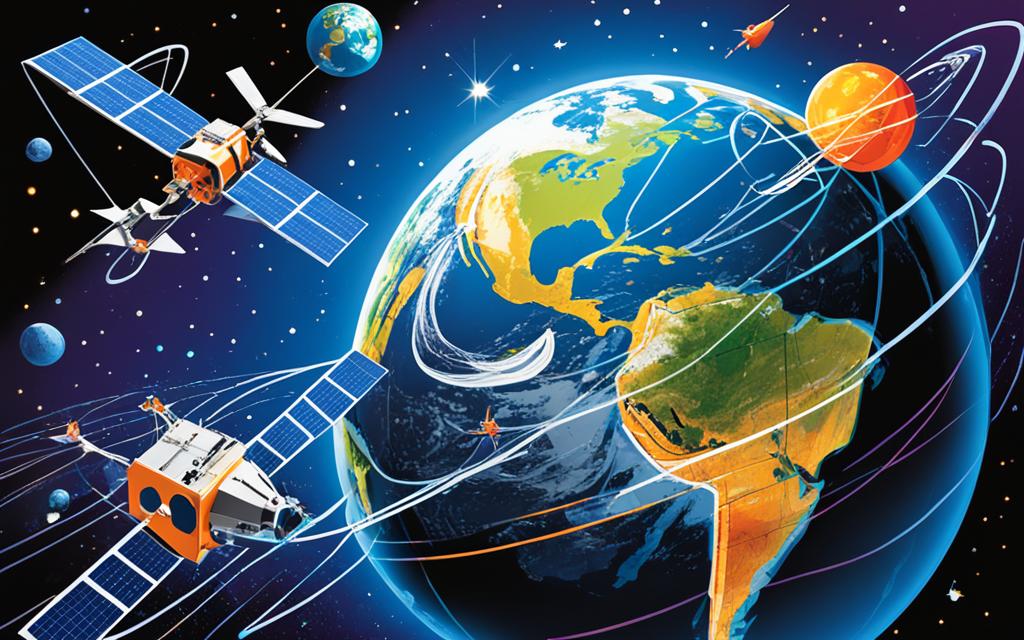
The Rise of LEO Satellite Constellations
The satellite industry is undergoing a transformative shift with the emergence of LEO (Low Earth Orbit) satellite constellations. Companies like SpaceX, Amazon, and OneWeb are at the forefront of this revolution, aiming to provide broadband internet services to global populations.
Among these ambitious ventures, SpaceX’s Starlink is leading the way with thousands of satellites already deployed in orbit. This LEO constellation has showcased its potential by enabling emergency services and high-speed in-flight internet access.
While Starlink has taken a significant step forward, Amazon’s Kuiper project is still in the planning phase. However, once launched, Kuiper plans to deploy thousands of satellites to compete with existing terrestrial telecommunications companies and offer satellite broadband connectivity worldwide.
“The competition among these players has the potential to drive down prices and improve connectivity worldwide.”
The advent of LEO satellite constellations presents numerous advantages over traditional satellite systems. These constellations provide global coverage and low latency, making them ideal for bridging the digital divide and connecting remote areas.
The table below summarizes the key features of some prominent LEO satellite constellations:
| Company | Satellite Constellation | Number of Satellites | Main Objective |
|---|---|---|---|
| SpaceX | Starlink | Thousands | Global broadband internet |
| Amazon | Kuiper | Upcoming | Compete with terrestrial telecom companies |
| OneWeb | OneWeb | 648 (planned) | Global broadband connectivity |
The competition among these players is propelling innovation and driving advancements in satellite technology. As these constellations continue to grow, they have the potential to provide affordable, high-speed internet access to underserved communities, connecting billions of people around the world.
The Future of Satellite Broadband
The rise of LEO satellite constellations represents a significant shift in the way we think about satellite broadband. The competition with terrestrial providers and the potential for decreased costs and improved connectivity will shape the future of internet access. As the technological capabilities of these constellations continue to develop, it is essential to navigate the challenges of spectrum allocation and orbital congestion, ensuring safe and sustainable operations for the crowded sky above us.
Navigating the Crowded Sky: Space Situational Awareness
The increasing number of satellites in orbit, both in GEO and LEO, raises concerns about potential collisions and orbital debris. Satellite collisions can have significant consequences, such as damaging operational satellites, generating more debris, and potentially hindering our access to space. Therefore, space situational awareness (SSA) and effective space traffic management (STM) have become critical for the safe operation of satellites.
SSA involves tracking and monitoring objects in space to precisely determine their location, trajectory, and potential collision risks. While government entities have traditionally provided SSA data, commercial SSA providers are emerging to supplement this information. These commercial providers offer additional real-time tracking capabilities, augmenting the existing government databases and allowing satellite operators to make more informed decisions about their operations.
To address the growing concern of orbital debris, the development of in-orbit satellite servicing and space debris removal missions is underway. These missions aim to actively remove defunct satellites, spent rocket stages, and other debris from orbit, reducing the risk of collisions and the creation of further debris. By removing these objects, the space environment becomes safer for future satellite deployments and space exploration.
“Space situational awareness and effective space traffic management are crucial for the safe operation of satellites.”
Table: Comparison of Key Space Situational Awareness Providers
| Company | Capabilities |
|---|---|
| LeoLabs | Real-time tracking of objects in LEO |
| ExoAnalytic Solutions | SSA data and analytics |
| AGI (Analytical Graphics Inc.) | Satellite tracking and conjunction analysis |
| Thales Alenia Space | SSA services for government and commercial customers |
These advancements in space situational awareness and orbital debris removal will be essential for the long-term sustainability of satellite operations. By actively monitoring and managing the crowded sky, satellite operators can minimize the risk of collisions and safeguard the reliability and availability of critical space-based services.
Conclusion
Geostationary satellites continue to be the stalwarts of communication and broadcasting systems, providing essential services to people worldwide. However, the satellite industry is experiencing a significant transformation with the rise of low Earth orbit (LEO) satellite constellations. Major players like SpaceX and Amazon are heavily investing in satellite ventures to bring broadband connectivity to remote areas and bridge the digital divide.
While this shift presents challenges such as orbital congestion and spectrum allocation, the competition in this space is driving technological advancements and has the potential to revolutionize internet connectivity on a global scale. Through projects like SpaceX’s Starlink and Amazon’s Project Kuiper, the satellite industry is paving the way for enhanced broadband access and unlocking new opportunities for communication and innovation.
The future of the satellite industry lies in striking the right balance between geostationary (GEO) and LEO satellites. As we navigate the crowded sky, it is crucial to ensure safe and sustainable operations by leveraging space situational awareness and effective space traffic management. With the ever-increasing number of satellites orbiting the Earth, commercial space situational awareness providers and initiatives for orbital debris removal are essential in preserving the integrity of satellite operations.
Ultimately, the satellite industry holds immense potential to reshape the way we connect and communicate. By harnessing the capabilities of geostationary satellites and embracing the advancements brought by LEO satellite constellations, we can create a future where broadband connectivity knows no bounds and empowers individuals and communities worldwide.
FAQ
Why are geostationary satellites important for global communication and broadcasting systems?
Geostationary satellites are critical for global communication and broadcasting systems because they orbit at the same speed as the Earth’s rotation, allowing them to remain fixed in a specific position relative to the Earth’s surface. They provide reliable and uninterrupted communication services, including internet access, television broadcasting, and telephony.
Which companies are investing in satellite ventures for expanding telecommunications capabilities?
Companies like Amazon are investing in satellite ventures like Project Kuiper to expand their telecommunications capabilities and provide internet access to remote areas. This investment aims to bridge the digital divide and improve connectivity worldwide.
What is the competition in the satellite industry regarding broadband internet services?
In recent years, there has been a surge in the development of satellite constellations for broadband internet services. Companies like Amazon’s Project Kuiper and SpaceX’s Starlink are competing to deploy thousands of satellites in Low Earth Orbit (LEO) to provide high-speed internet access to even the most remote areas of the planet. This competition has the potential to revolutionize internet connectivity.
What challenges do geostationary satellite operators face in the evolving satellite industry?
Geostationary satellite operators, such as ABS, Spacecom, and OneWeb, face challenges in the evolving satellite industry. While these operators have established satellite businesses serving the broadcast community, they need to explore new revenue streams to remain competitive. The decline in GEO satellite orders raises questions about the long-term viability of pure GEO operators.
How are LEO satellite constellations reshaping the satellite industry?
LEO satellite constellations, such as SpaceX’s Starlink, Amazon’s Kuiper, and OneWeb, are reshaping the satellite industry. These constellations aim to provide broadband internet services with global coverage and low latency. With thousands of satellites in orbit, SpaceX has already demonstrated the utility of its system in emergency services and high-speed in-flight internet access. The competition among these players has the potential to drive down prices and improve connectivity worldwide.
What are the concerns related to the increasing number of satellites in orbit?
The increasing number of satellites in orbit, both in GEO and LEO, raises concerns about potential collisions and orbital debris. Ensuring space situational awareness (SSA) and effective space traffic management (STM) are crucial for the safe operation of satellites. Commercial SSA providers are emerging to augment government data and provide real-time tracking of objects in space. In addition, in-orbit satellite servicing and space debris removal missions are being developed to mitigate the risks of orbital debris. These advancements will be essential for the long-term sustainability of satellite operations.
What is the future of the satellite industry?
Geostationary satellites continue to play a vital role in communication and broadcasting systems. However, with the emergence of LEO satellite constellations, the satellite industry is undergoing significant changes. The competition and advancements in LEO broadband internet services have the potential to revolutionize internet connectivity and bridge the digital divide. Striking the right balance between GEO and LEO satellites is crucial for ensuring safe and sustainable operations in the crowded sky.

